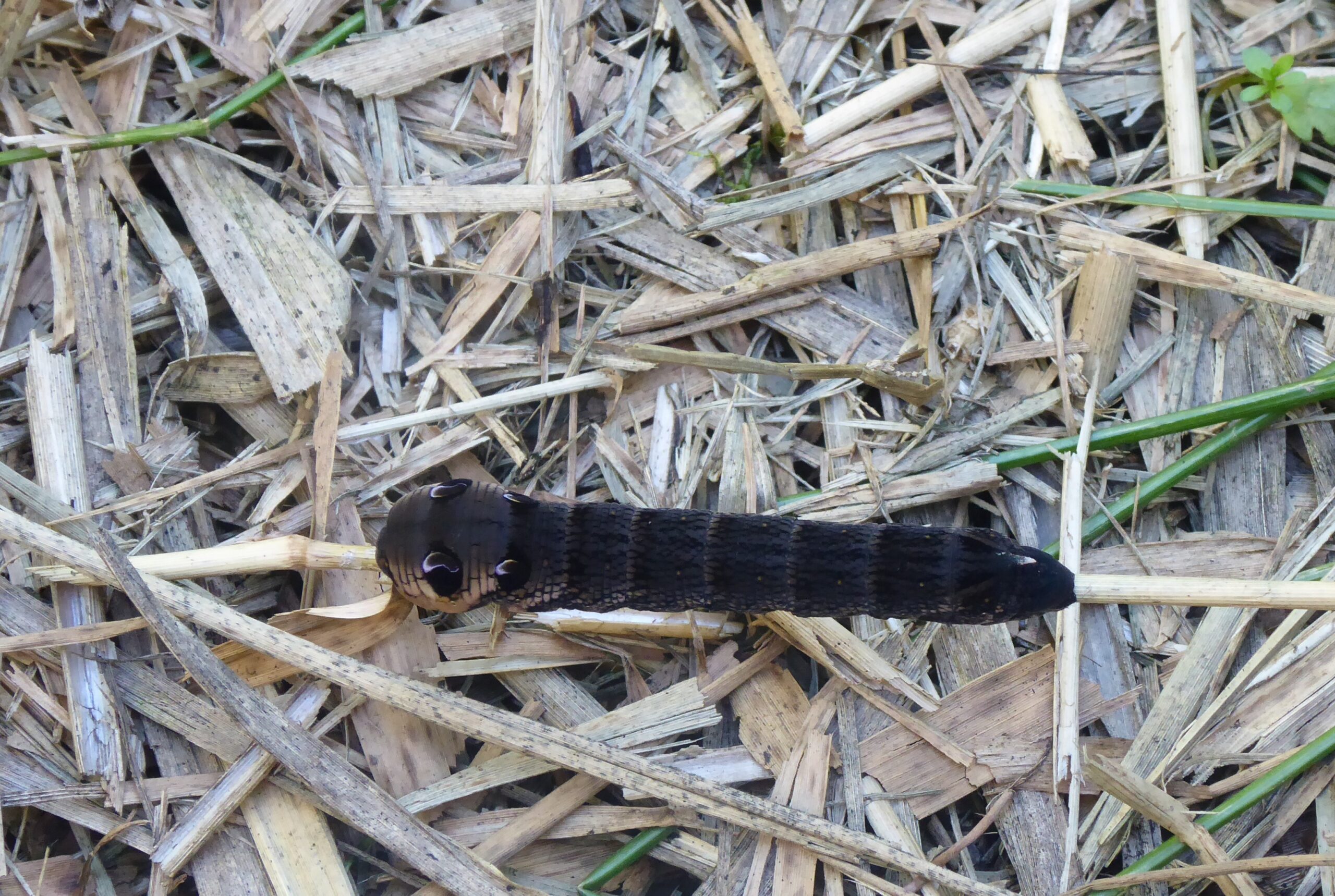Yesterday, when I went for a walk round the garden, I didn’t find much that was new. It was hot and sunny with a stiff breeze to keep it a comfortable temperature. There are still some butterflies around – I saw Red Admirals, Small Heath, whites, a Meadow Brown, and a Speckled Wood. There are grasshoppers, flies, and spiders. Then I spotted a fat black caterpillar on the path in Little Venice. What looked like a tiny plush draught excluder was, in fact, an Elephant Hawk Moth Caterpillar. It has four false eyes to make predators think it is a lot bigger and fiercer than it actually is. Elephant Hawk Moths are a stunning pink and green combo. They are seen from May to July and the caterpillars from July to September. They eat nectar from bedstraws and willowherbs, both of which are still flowering in the watermeadow. The fact that the caterpillar was on the ground means it might be getting ready to pupate. I’m hoping that it withdraws back into the long grass to do that.
-
Orb-weaver Spider and two types of Wolf Spider
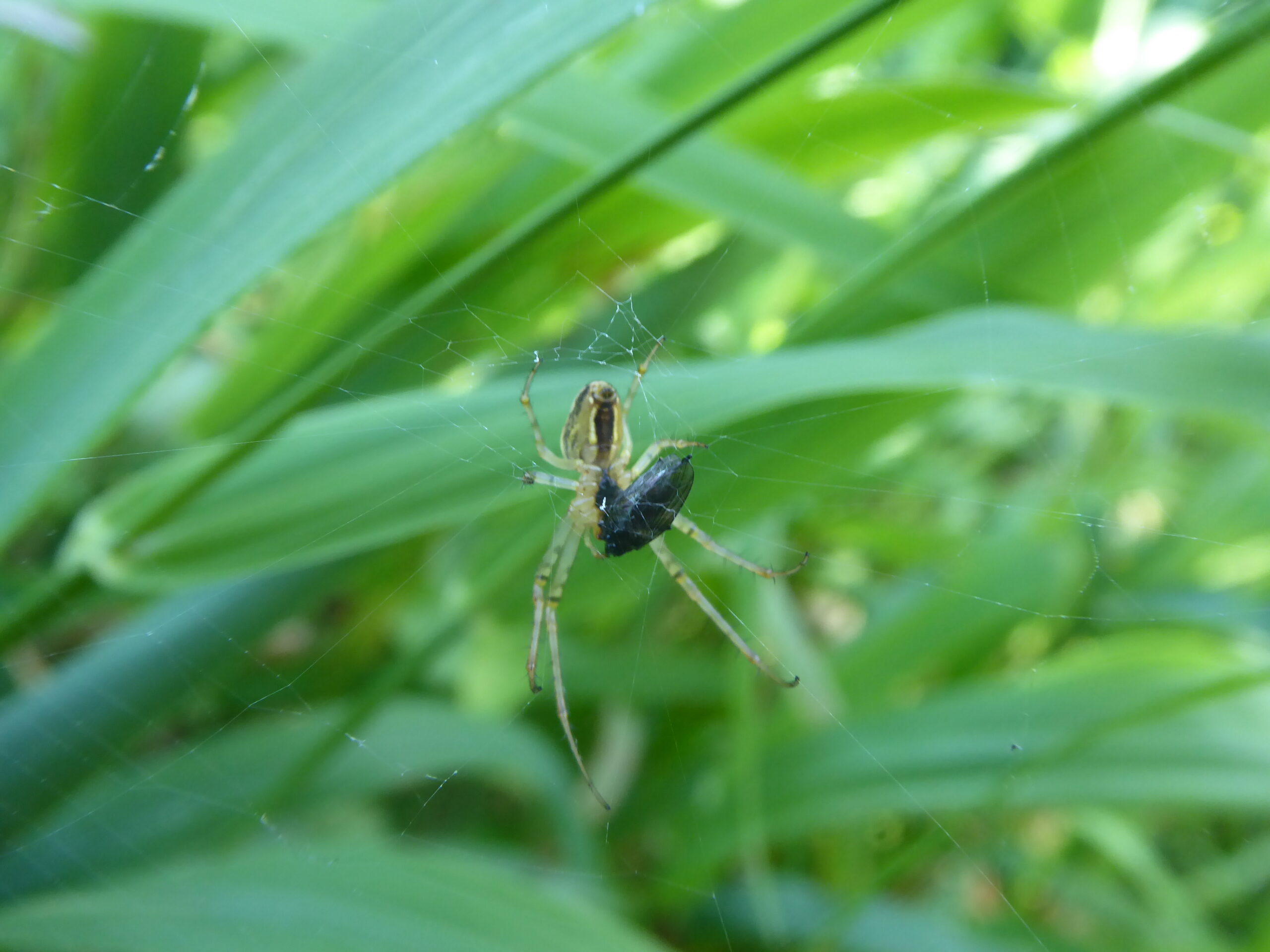
This is a common orb-weaver spider with some prey. Orb-weavers are so-called because they make circular webs. There is an orb-weaver called a missing sector orb-weaver which builds a web with a missing quadrant and only a single thread attaching the web from that quarter. You might be able to see from the photo that this web is complete, so it is a common orb-weaver.
There are two variants of the Common Orb-weaver Spider Metallina mengei has a longer dark stripe on its abdomen than M. segmentate. This is the former.
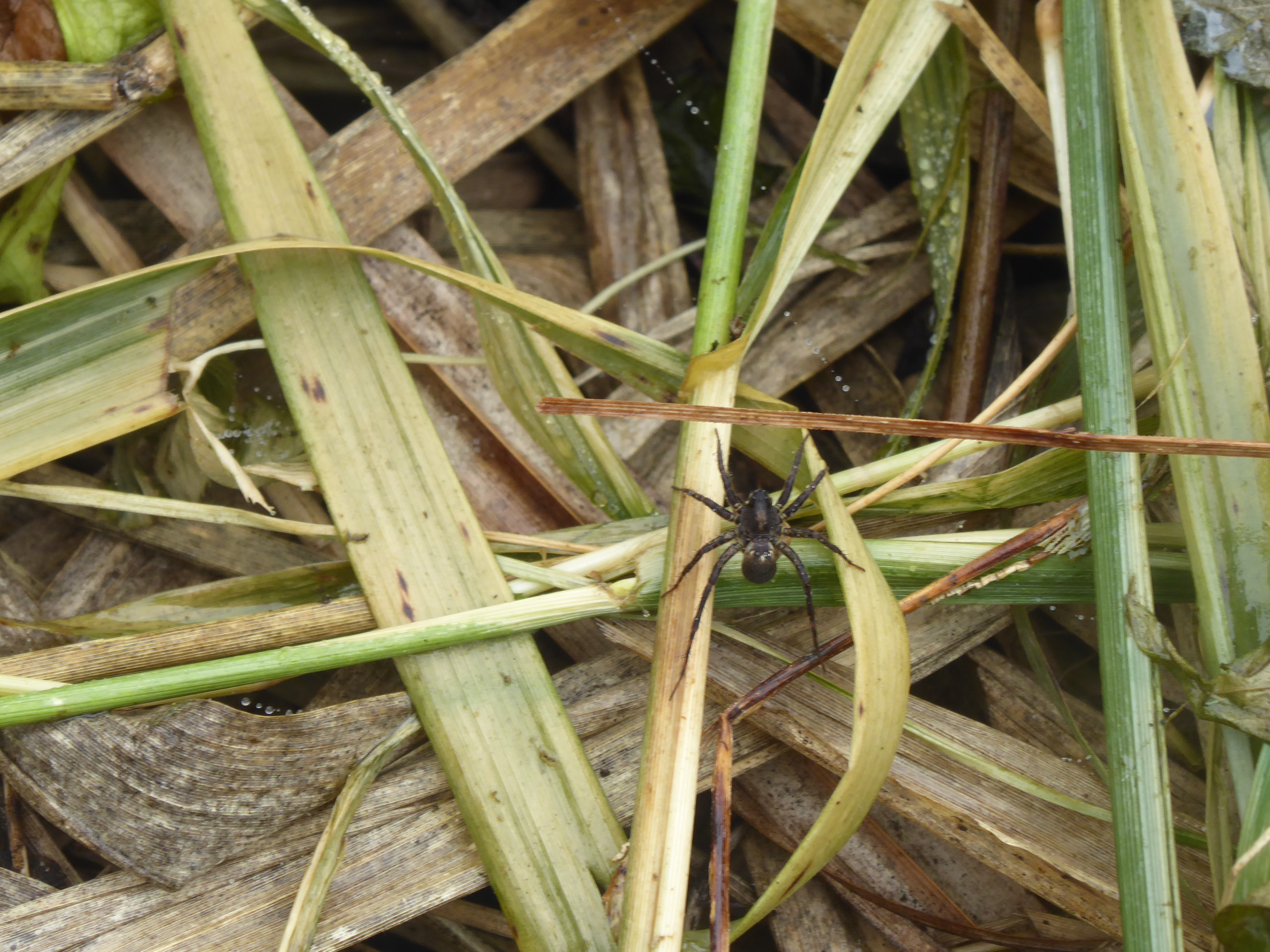
Wolf spiders were running over a pile of dry grass in the far left-hand corner of the watermeadow. This is a female carrying an egg sack under her body. Around one hundred baby spiders will hatch dramatically and hitch a lift on her back for a few days before floating away on silk parachutes. Wolf-spiders are so-called as they hunt down prey, rather than catching it in a web. There are several species of wolf spider, but it is difficult to tell them apart without close examination. This one was black and bristly.

This is a different wolf spider. It was tweedy grey and hairy. It looked like a Pardosa milvina, or shore spider, which is found in wetlands but in North America, so it must be a European variant of that sub-species, as I couldn’t find anything about it being an invasive species to the UK.
-
Field Vole
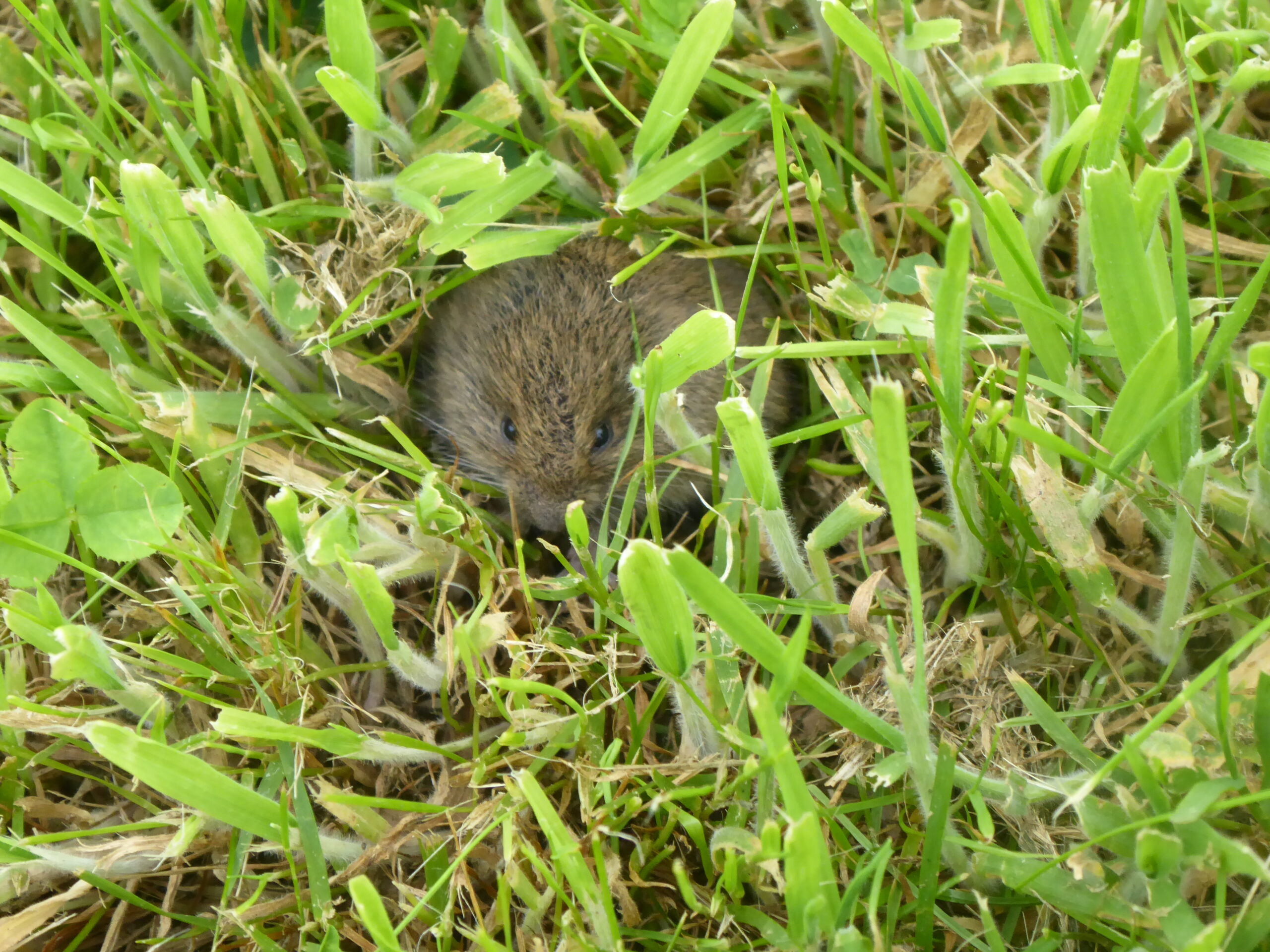
We’re not sure what this field vole was doing out in the open, but he seemed chirpy enough and scuttled away after his photoshoot.
But firstly, is it a vole or a mouse? Voles have much shorter tails than mice, smaller ears and rounder, blunter faces.
Secondly, what type of vole is it? There are three to choose from. The water vole is much larger, about the size of a rat, but with a shorter furry tail. It is also darker in colour. The bank vole is brown, rather than grey-brown, and smaller with a slightly longer tail.
So, this is a field vole, gray-brown, with a paler grey belly and noticeably shaggy fur. It lives in grassland, so probably has a hole in our bank, but voles prefer to make runs through the grass, rather than tunnels through the earth. They eat plant matter – seeds, roots, leaves – and can have up to six litters of up to seven babies a year. Unfortunately, that’s 42 snacks for a lot of animals and birds. Their average lifespan is only one year.
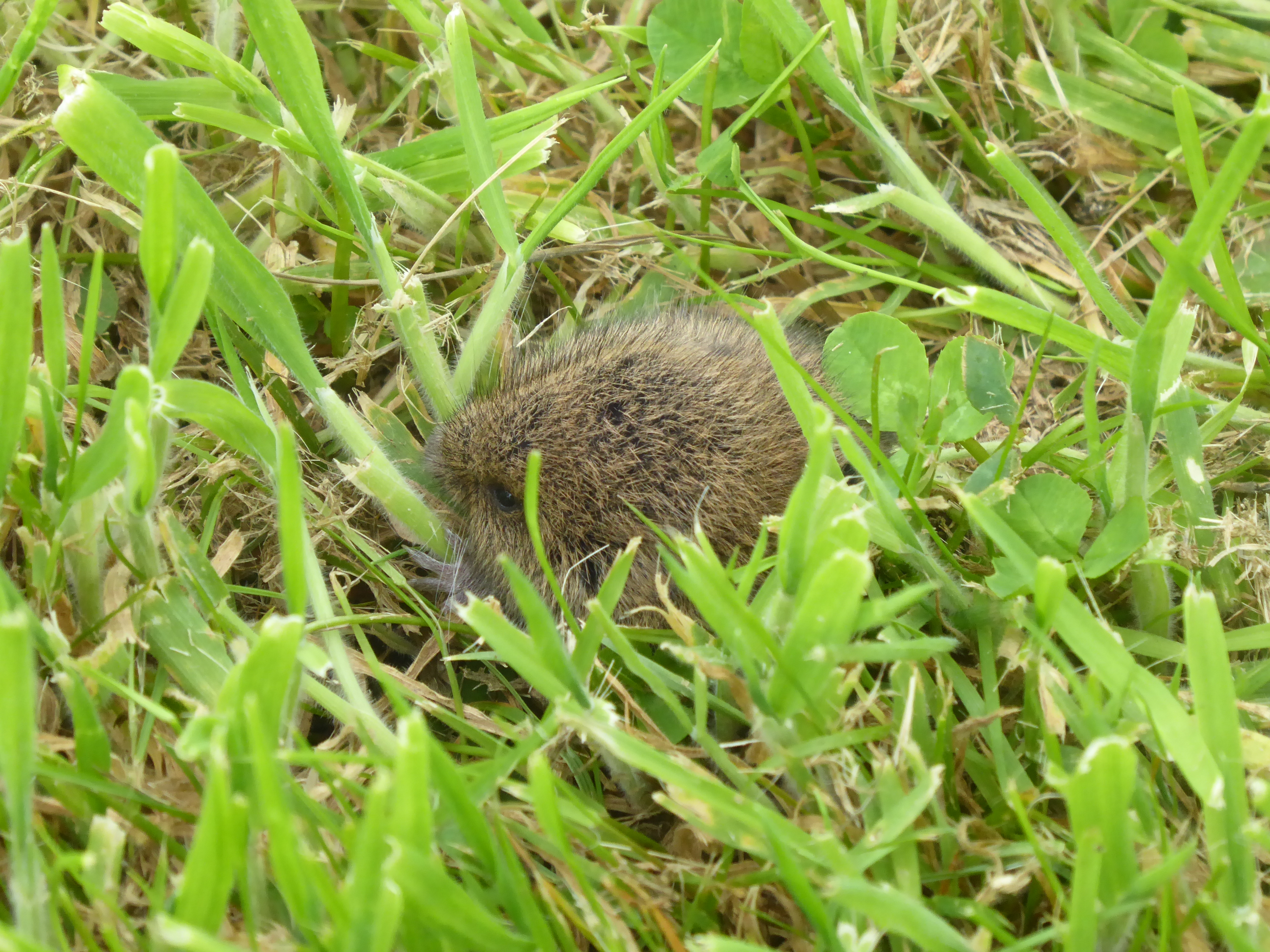
-
Finding my marbles! Rush Marble and Common Marble Moths
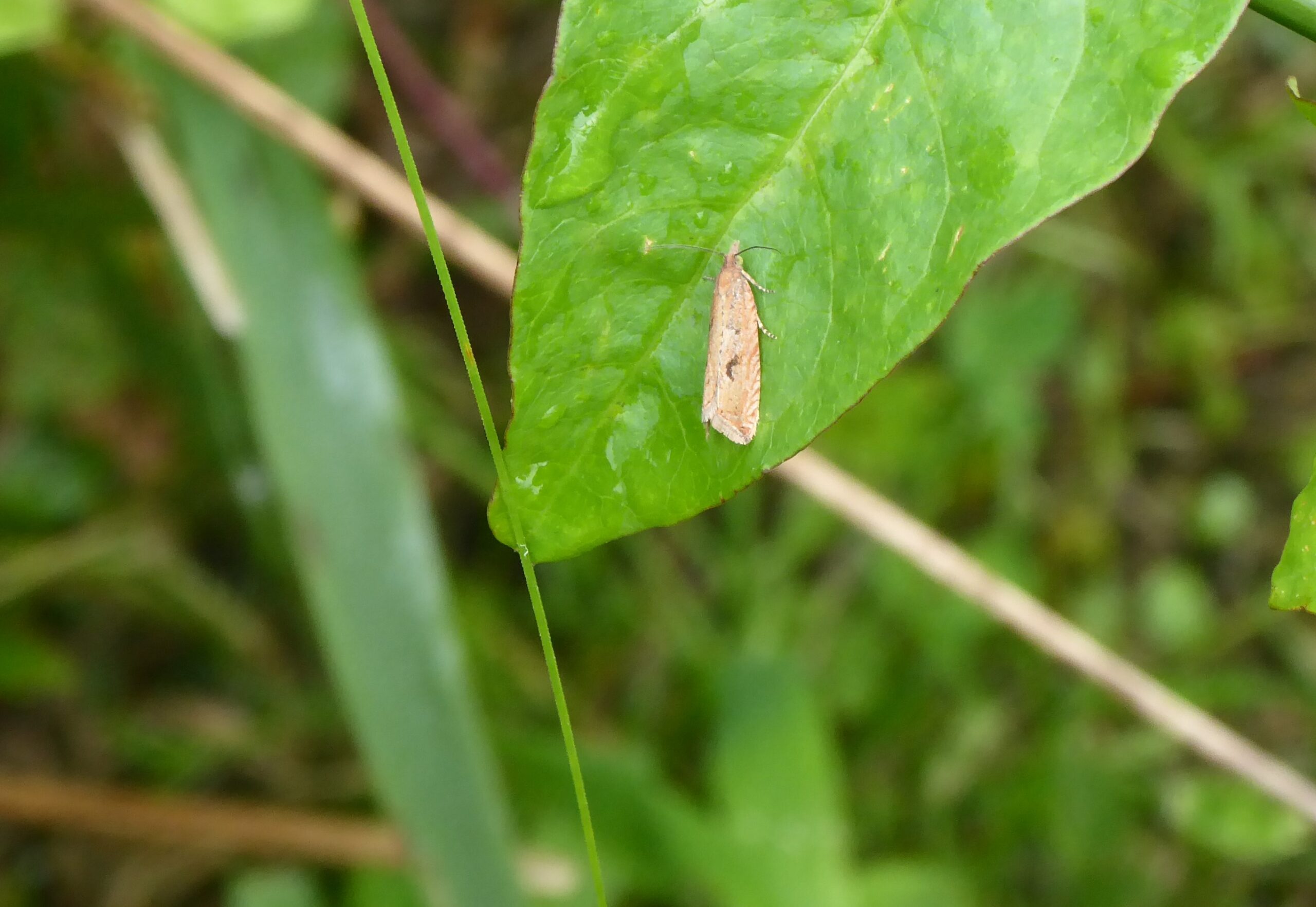
I really love how collecting photos of the wildlife in our watermeadow has made me look at the detail and appreciate the beauty in some of the little creatures. Take this rush marble – I was searching for ‘wood grain moths with stripey legs’ and of course I got nowhere. But just look at the wing borders with the wood grain patterning. It’s so delicate, and yet, so easy to overlook.
I had already identified the common marble moth below and noticed that the fringing on the wings and the general shape were similar, so I looked up ‘marble moths’ and discovered the whole range. I was able to pick out the lovely tan colour, ‘wood grain’ stripes and the dark ‘kidney’ markings.
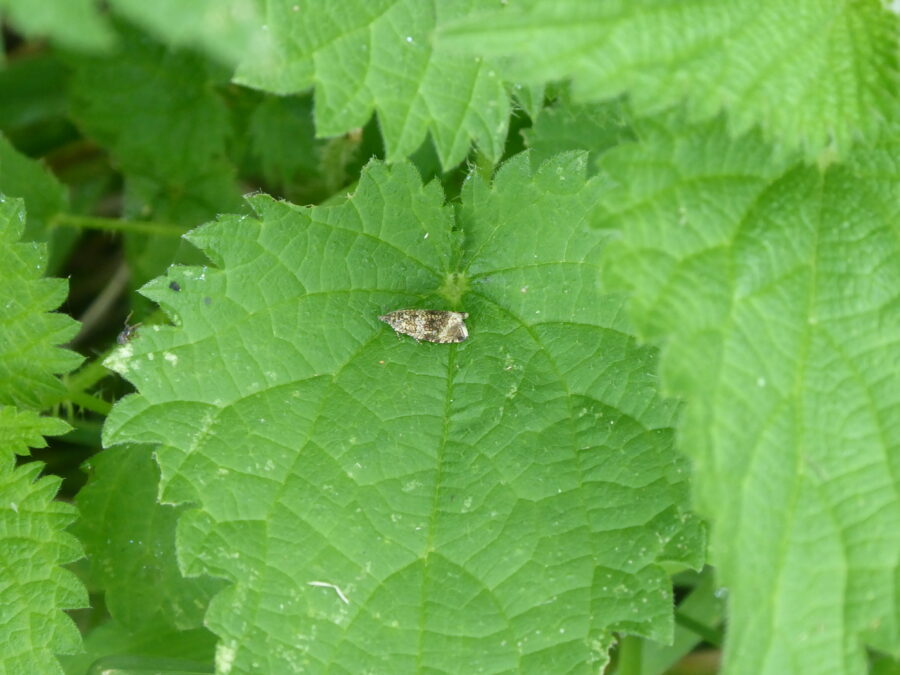
As previously mentioned there are a number of tweedy looking black and white moths, which are in the Tortrix family. I identified this one as a dark strawberry tortrix, or common marble, by looking at the pattern and the striped legs. The pattern has a white fringe with a slim black border stripes running in diagonal swathes across the wings with a broad dark band between two paler bands and narrower stripes in the wing margins. Apparently these black and white marbled moths are supposed to resemble bird droppings!
The moth likes grasslands, hedges, and woodland fringe and flies May to August. There are a great many moths in the Tortrix family, and most seem to be viewed as pests. The word tortrix is Latin for ‘twister’ and refers to the way in which the caterpillars roll up leaves to make their cocoons.
-
Hairy Shield Bug, Dock Bug and Tortoise Bug
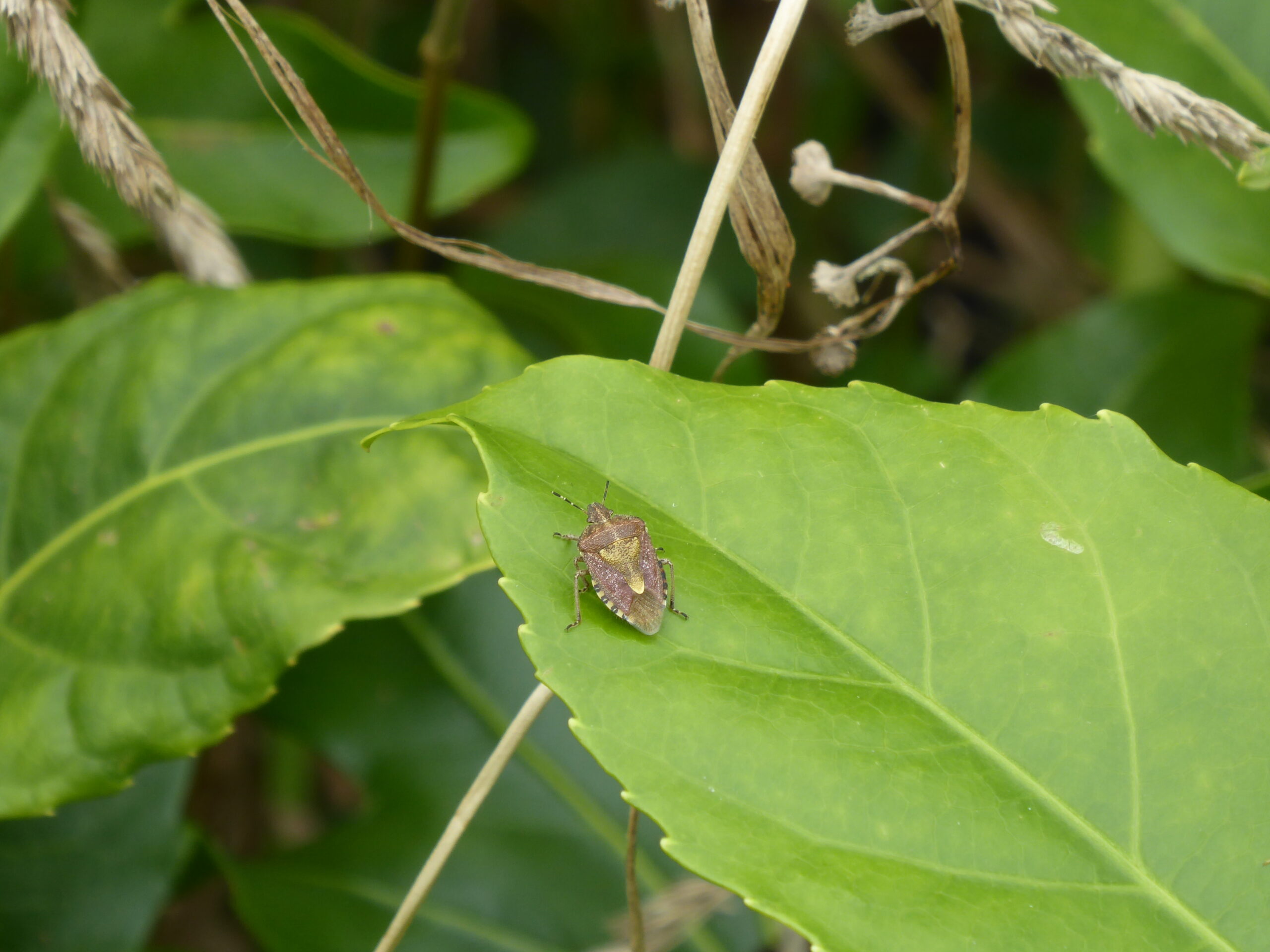
This is the Hairy Shield Bug (Dolycoris baccarum). It has very striking markings and is slightly hairy if you zoom in. New adults emerge from August, and it overwinters as an adult becoming a dull brown colour during that time. It is widespread and can be found in hedgerows and woodland edges. This one was under the willow trees on the left-hand side of the garden.
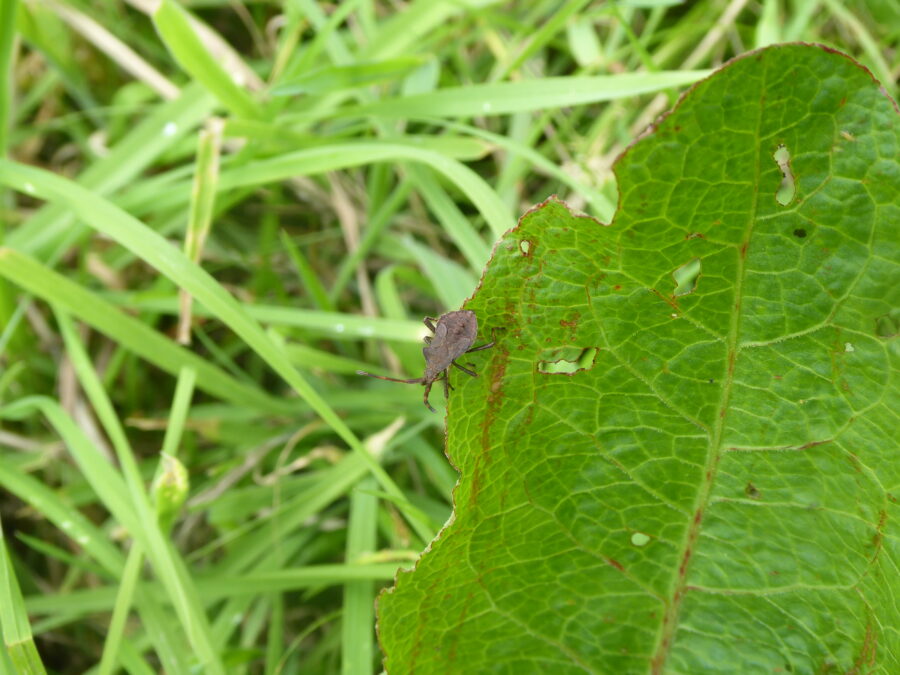
Google lens told me that this was a dock bug, but it didn’t look like some of the pictures. Then I found a helpful diagram (www.ukwildlife.net) that showed the different stages of development and discovered that this is the final instar of a dock bug.
What is an instar? It’s the term used to describe the stages between moults of the larvae until the final adult emerges. The last stage of juvenile dock bug has small wings and a scaley body visible. The adults have larger wings that overlap their broad scaley body and broad shoulders that look armoured. They lay eggs in the spring. The first instar is red and black and looks quite cute and there are at least four stages of instar, before the adult dock bug emerges from August. Dock bugs don’t mind damp or dry habitat as long as there are docks or related plants for them to munch on.
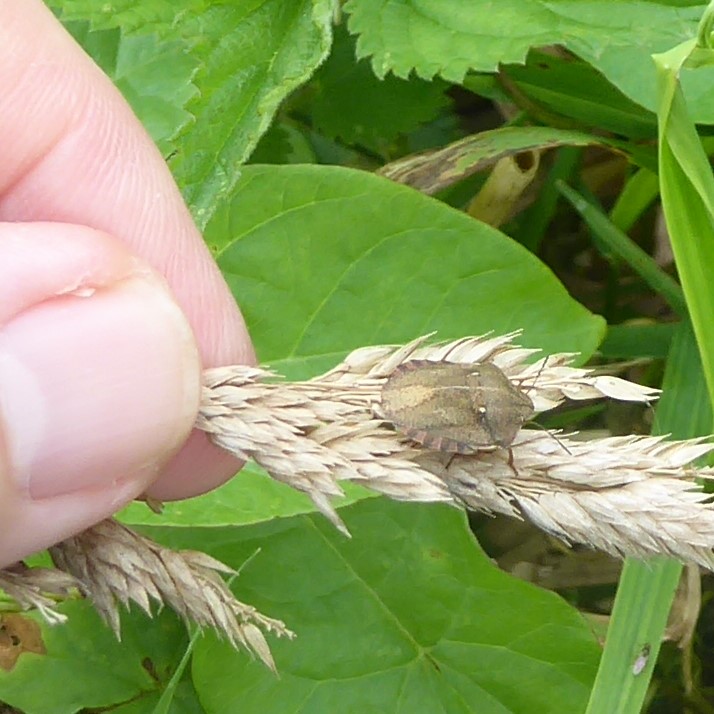
This is a tortoise bug – another shield bug. It’s different from the hairy shield bug as it is broader and flatter and has two white dots on its ‘shoulders’. The goblet marking is much slimmer and draws into a line up its back. This is the adult. The juveniles have more patterning.
There are two types of tortoise bug, but they are very difficult to distinguish so the Latin name reflects this – Eurygaster cf testudinaria – where cf means ‘likely to be’. The other tortoise bug is the much rarer Eurygaster maura.
It is found in damp and dry grasslands and is currently widespread in southern England, though it used to be uncommon.
-
A Comma, and a Knot Grass Moth Caterpillar
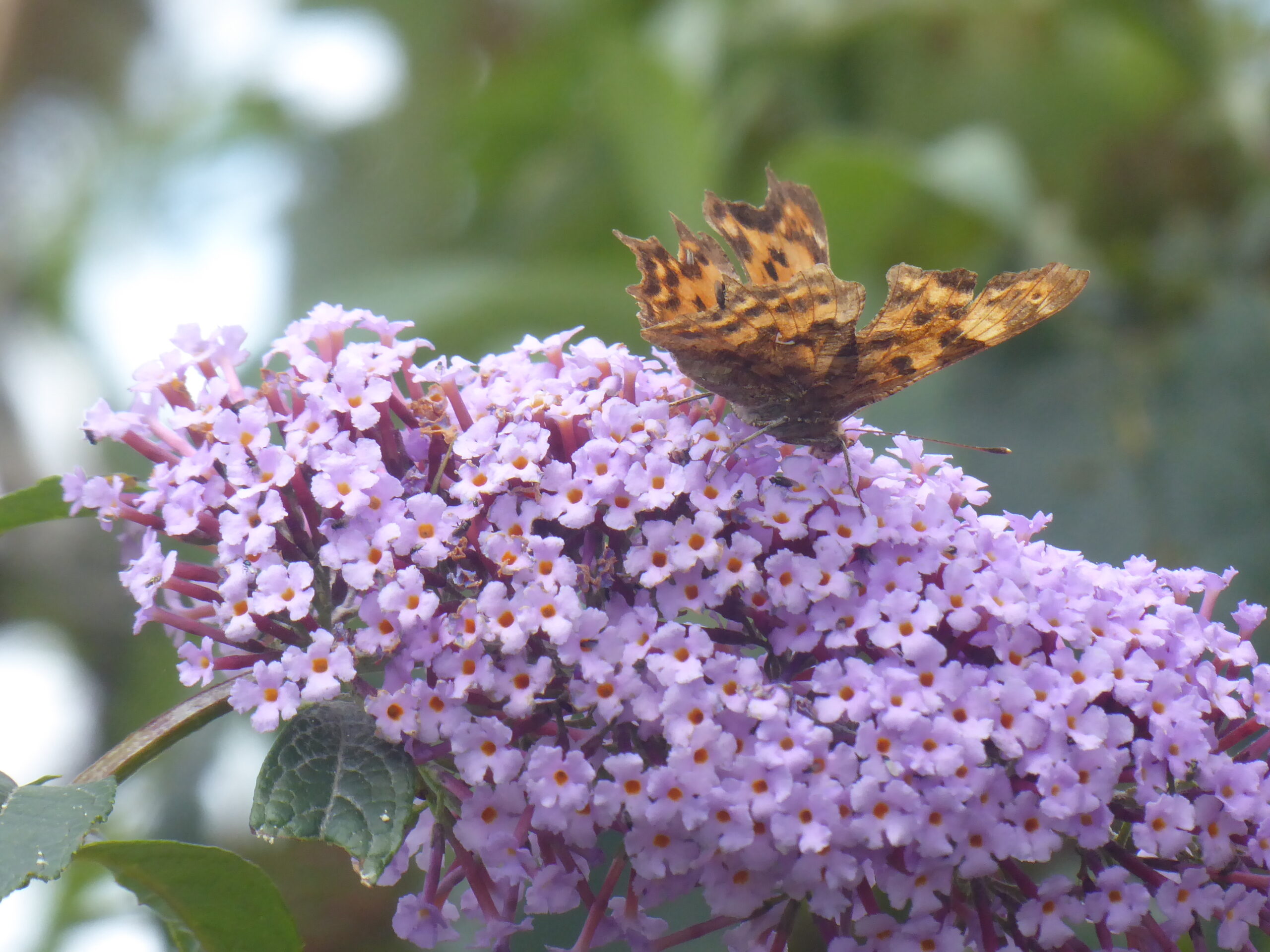
I lost some photos. I must have deleted them by mistake. A painted lady and a comma, which we saw last week. Too late for the Big Butterfly Count worse luck, but lovely to see anyway. I’m amazed by the number of butterflies we are seeing in the garden, but I was upset to lose the photos as the butterflies are starting to look the worse for wear and although we still have many Red Admirals, Whites and Small Heath butterflies, I wasn’t holding out much hope of seeing another painted lady or comma. Plus, we’d been for a walk and a massive grey cloudbank had obscured the sun and wasn’t showing signs of moving.
I waited, patiently, for the sun to come out again. I took a lot of photos of bugs and bees, but there weren’t many butterflies around. After nearly an hour, the cloud shifted, and the sun came out. Suddenly the garden was alive with butterflies! Yes, the ‘usual’ ones, but at last I noticed the ragged wings of the comma – and then a tortoiseshell, which is always an uplifting sight! No painted lady, but I’ll keep looking.
I found out why the comma is so-called. It’s because it has a white comma-shaped mark on the underside of its hind wings. You can see it quite clearly in the picture below where I was looking up at it. (Also in the main picture).
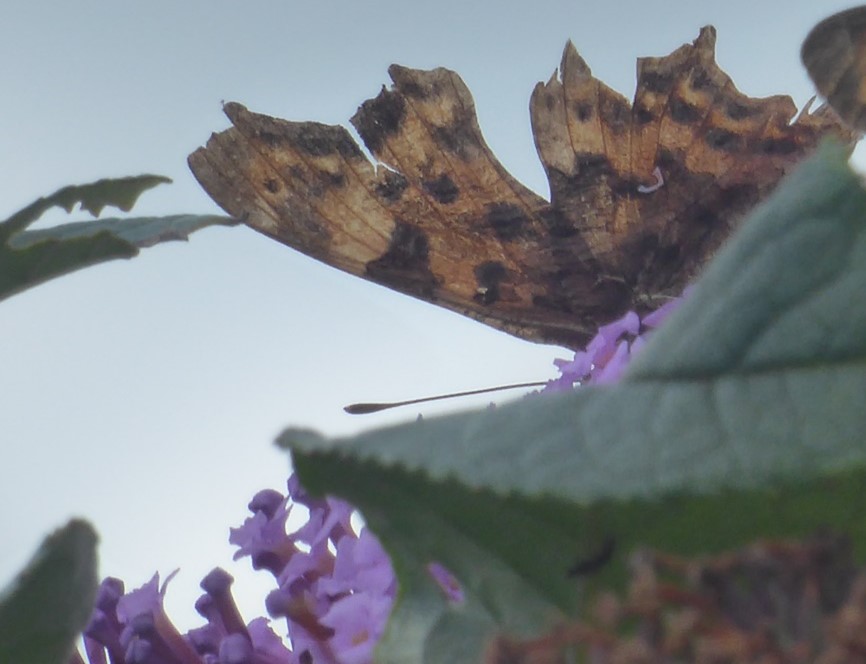
The next exciting find was a caterpillar! At this time of year! I thought we were finished with caterpillars, but no! Mr C. spotted this.
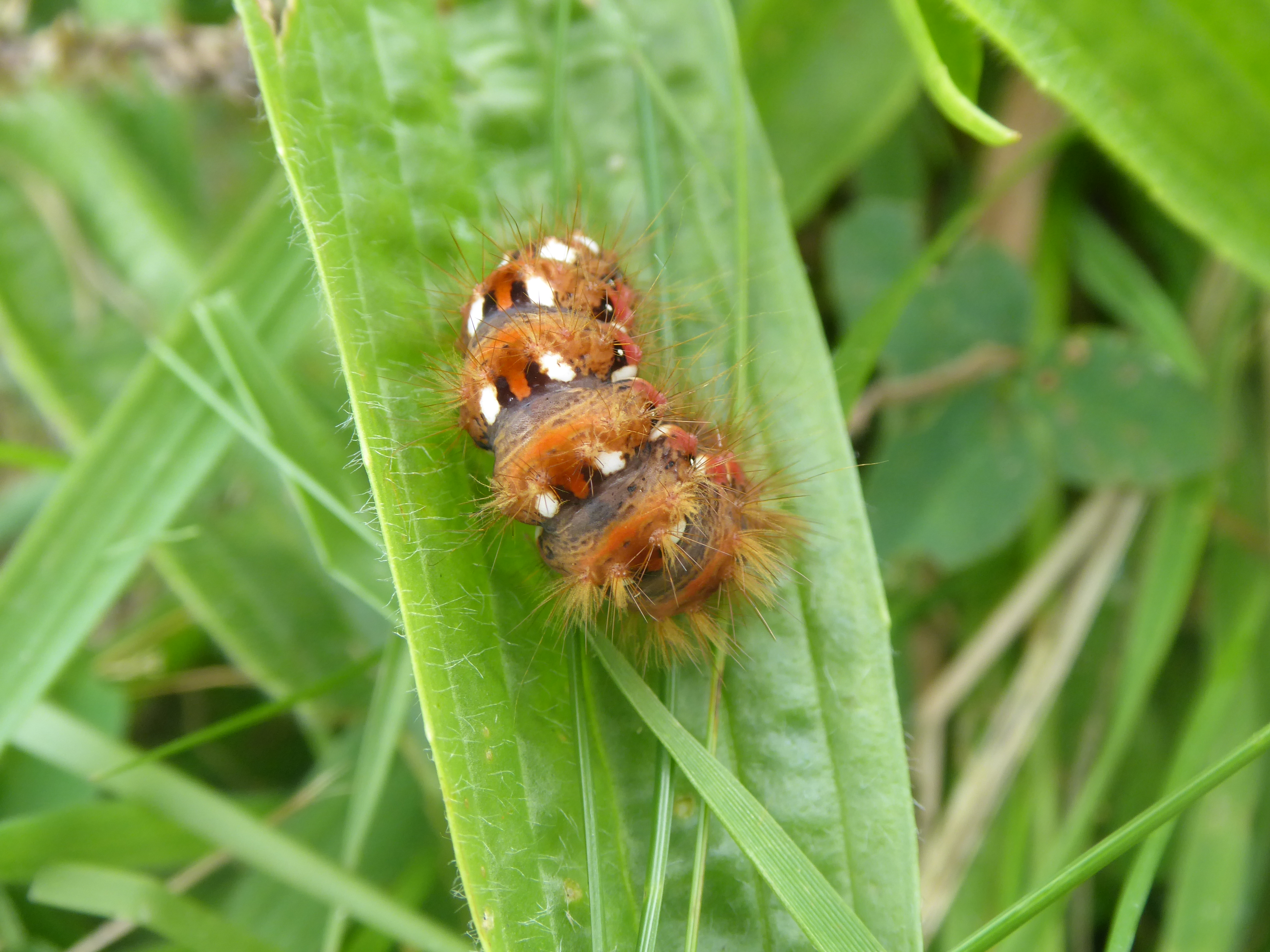
It’s the caterpillar of the knot grass moth, which is a black and white marbled moth with stripey legs. I have seen something similar, but haven’t identified it properly yet, as there are a great many black and white moths.
The knot grass moth itself is seen from May to July, but there is a second brood August to September. Caterpillars overwinter in a cocoon. The caterpillars feed on knot grass, docks and bramble and they prefer a damp environment.
-
Small Heath
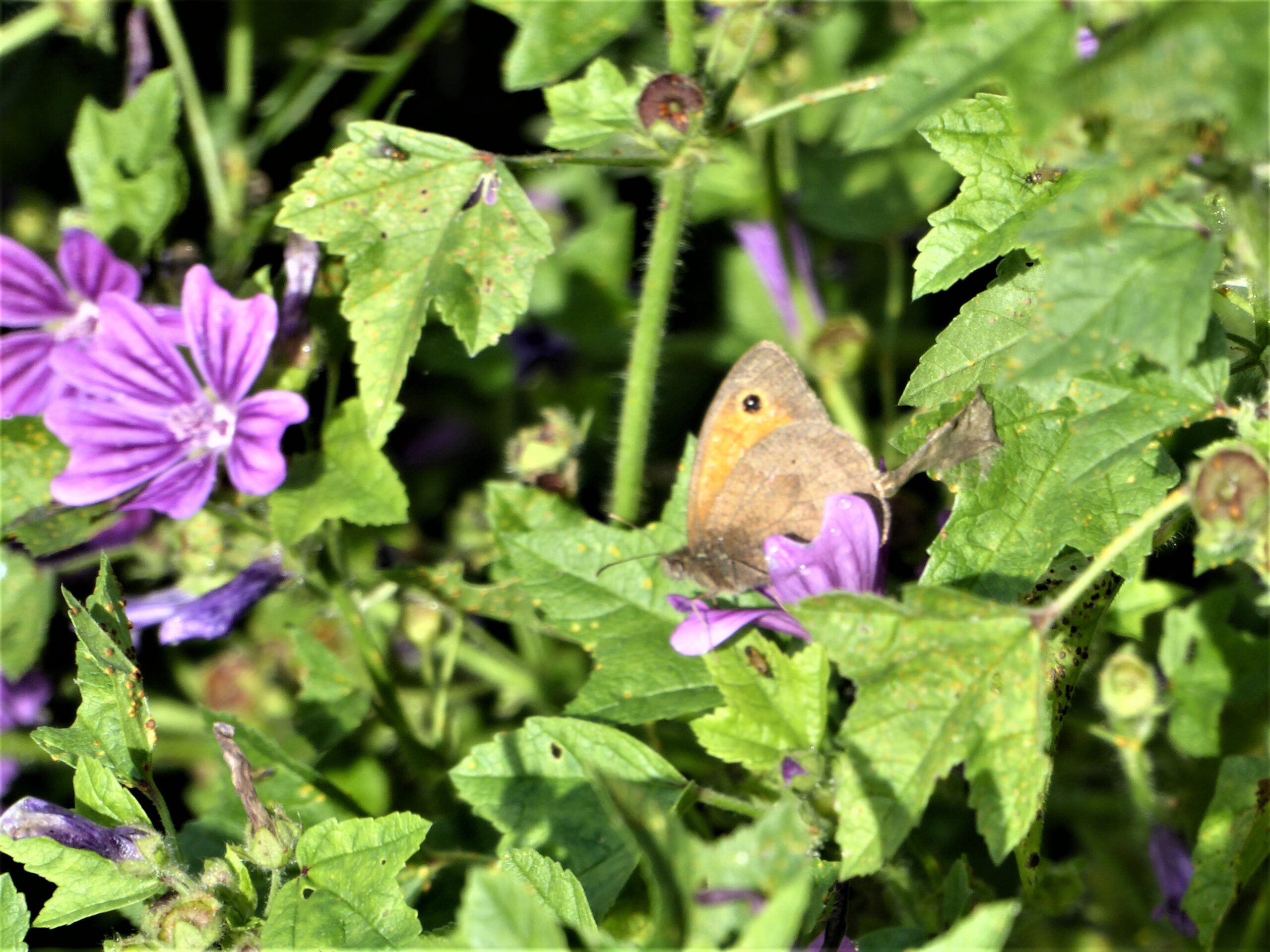
I was getting in a muddle with brown butterflies and thinking that this was a gatekeeper or meadow brown. Then I found a really useful article describing the meadow brown, gatekeeper, ringlet (which I haven’t seen yet), wall brown, speckled wood, grayling, and small heath. It was very useful, and I realised that this little butterfly is a small heath.
The most obvious factor for identification is the size, which is smaller than the gatekeeper and meadow brown. That’s all very well if you can compare them in real life, but at the moment our watermeadow is full of brown butterflies and they are all the same size and look like this one!
There are other clues. You will notice that the butterfly has its wings closed. The small heath never settles with its wings open and rarely ‘basks’ in the sunshine. Its obvious eye spot shows through onto the back of its forewings and is a visible deterrent to predators. (link) The eye spot is a white dot on a black spot which is ringed with buff. Other clues are the grey margin before the brown edge of the forewings and the jagged brown line on the hindwings.
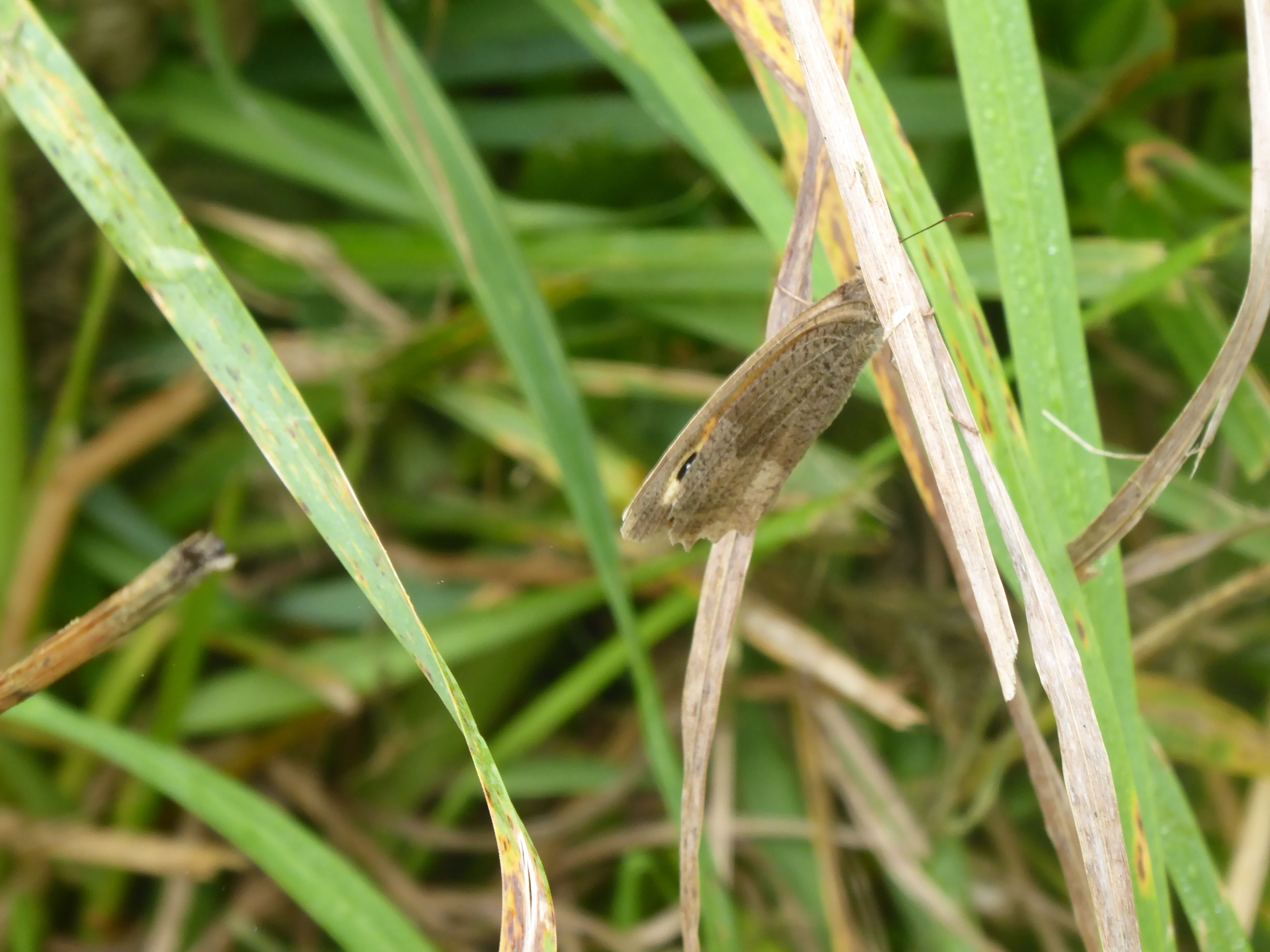
When it tucks its forewings behind its hindwings, it is camouflaged and as inconspicuous as an old leaf. -
Snail Special
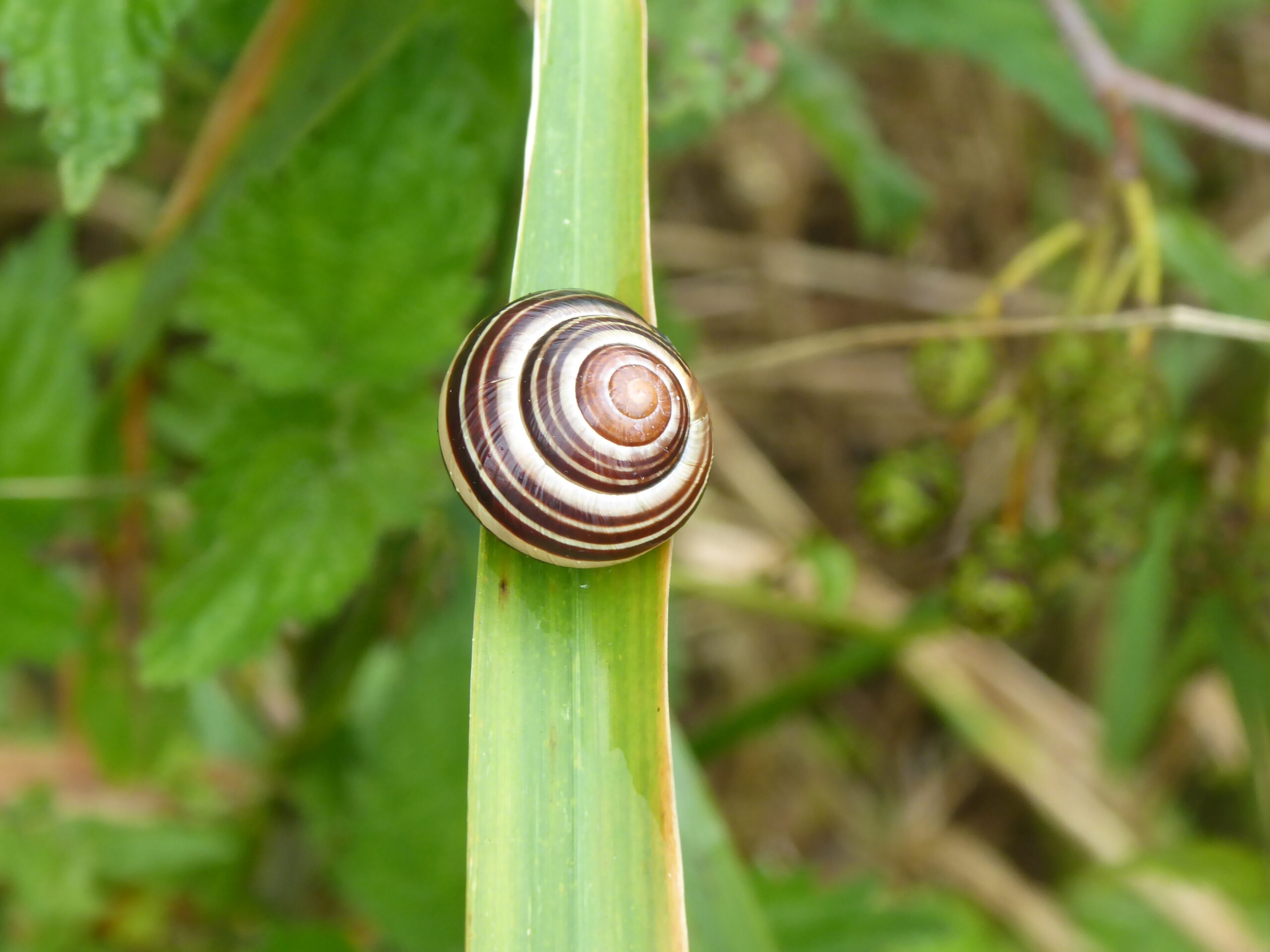
This is a Lipped Snail. These can be white-lipped or brown-lipped depending on the colour of the rim of the shell. It’s impossible to tell with the stripy one unless I manage to find it again and look specifically, as they come in many different colourways and it’s only the lip that defines which sort it is. Since I took this photo, I have seen both white-lipped and brown-lipped snails.
The white-lipped snail is usually yellow, but may be pink, brown, or red with up to five dark bands and nearly always has an obvious white lip. White-lipped snails live in damp vegetation. Their favourite foodstuffs are nettles, ragwort, and hogweed.
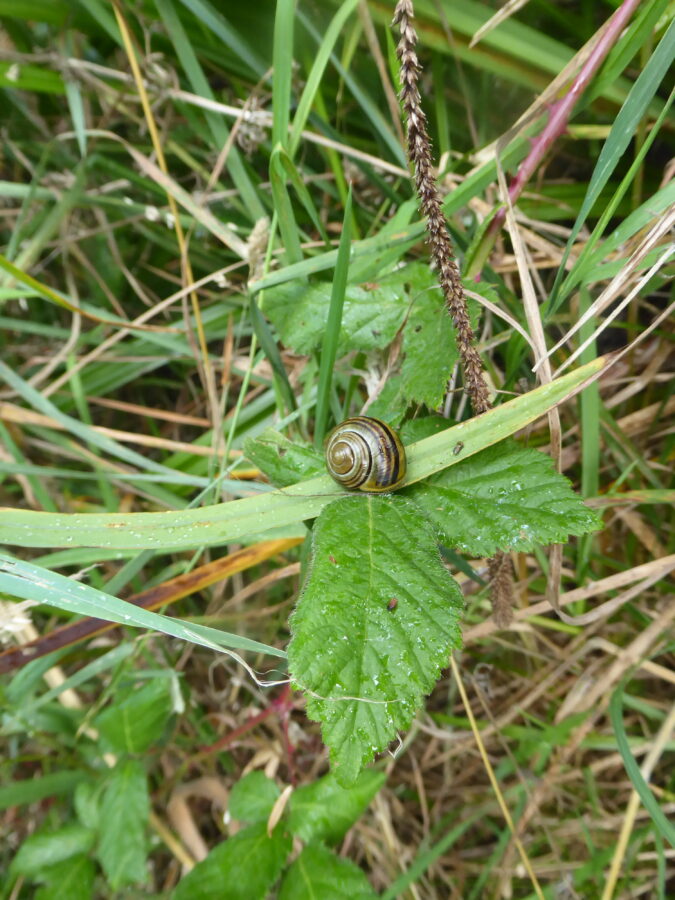
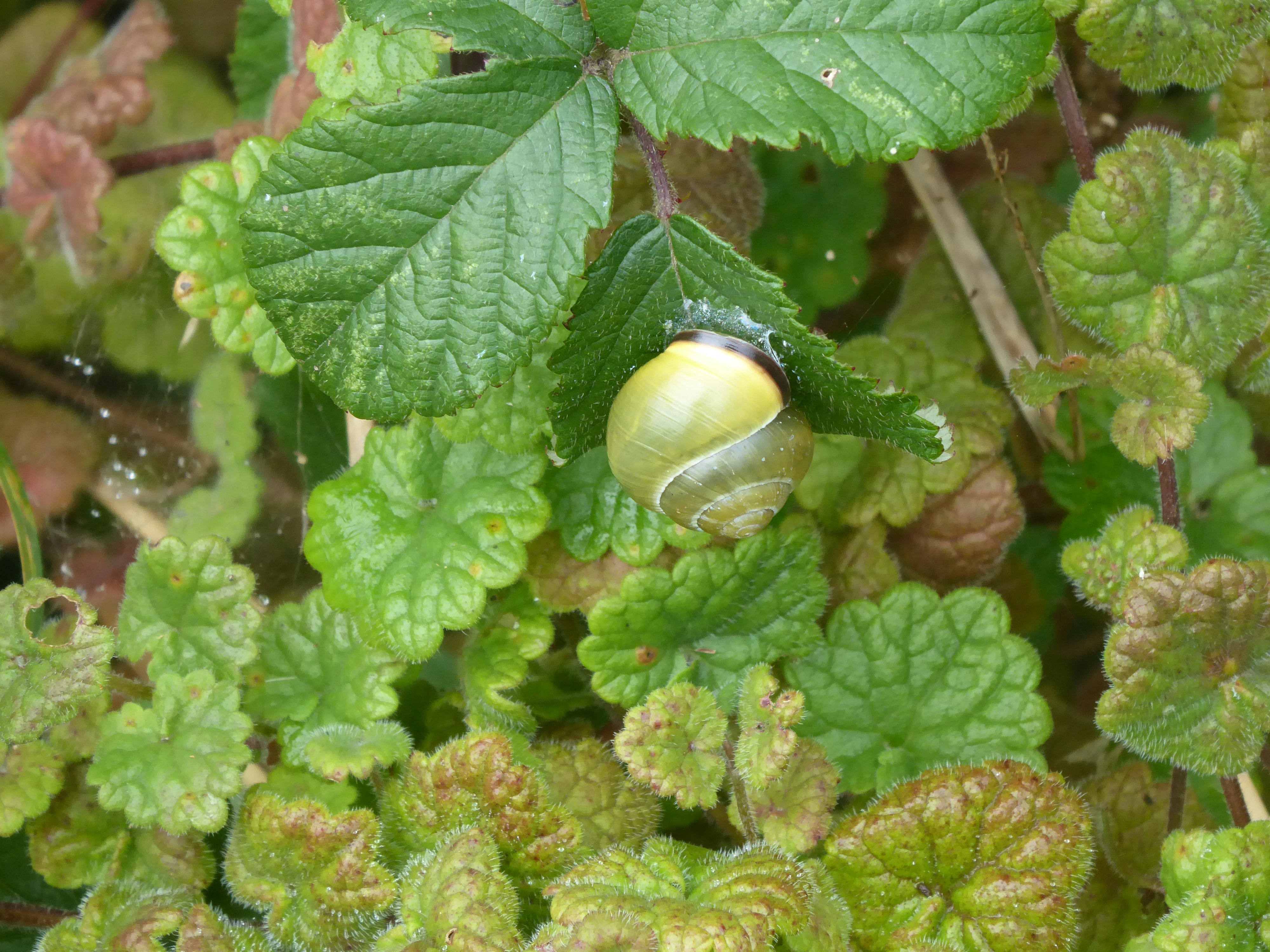
The brown-lipped snail typically has a stripy shell again with up to five bands, yellow through dark brown with pink or orange possible. Brown-lipped snails like a variety of habitats, but preferably damp. They are easier to spot in wet weather as they climb plants and trees then. They eat nettles and buttercups, but usually prefer dead or decaying foliage to fresh.
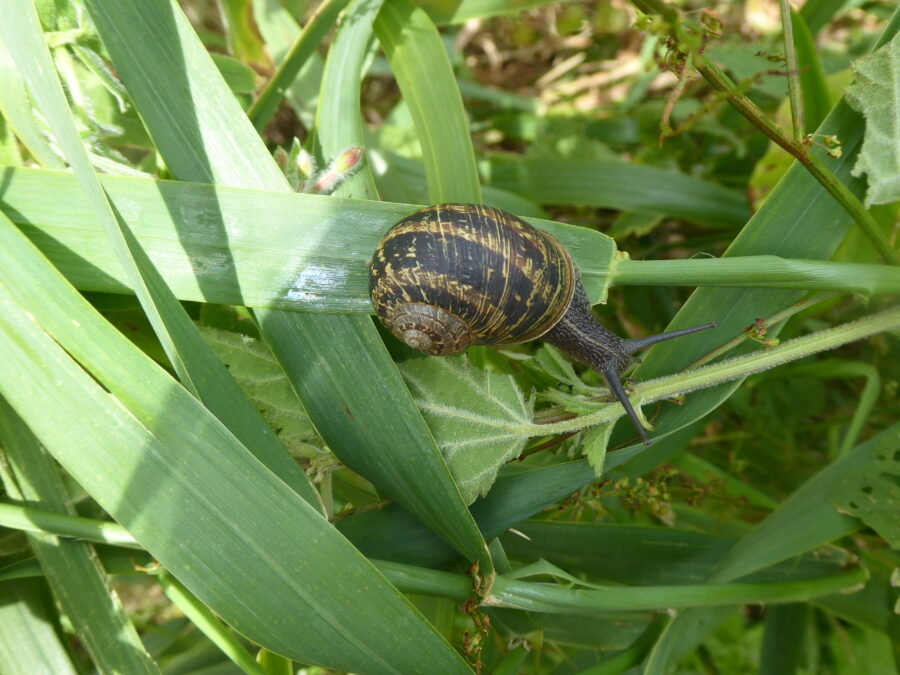
This is the Brown Garden Snail (Cornu aspersum, previously known as Helix aspersa). It is larger than the lipped snails with a thick shell, matt and rough in texture. It has dark spiral bands alternating with yellow-ish broken bands, giving quite a distinctive tweedy look. It is mainly nocturnal and omnivorous, preferring to eat plant matter, but occasionally eating worms, other snails, and dead animal matter. I found this quite surprising. And In spite of their diet, they are edible.
-
Two more wasps – Ichneumon Wasp (Diphyus quadripunctorius) and Sickle Wasp (Enicospilus ramidulus)
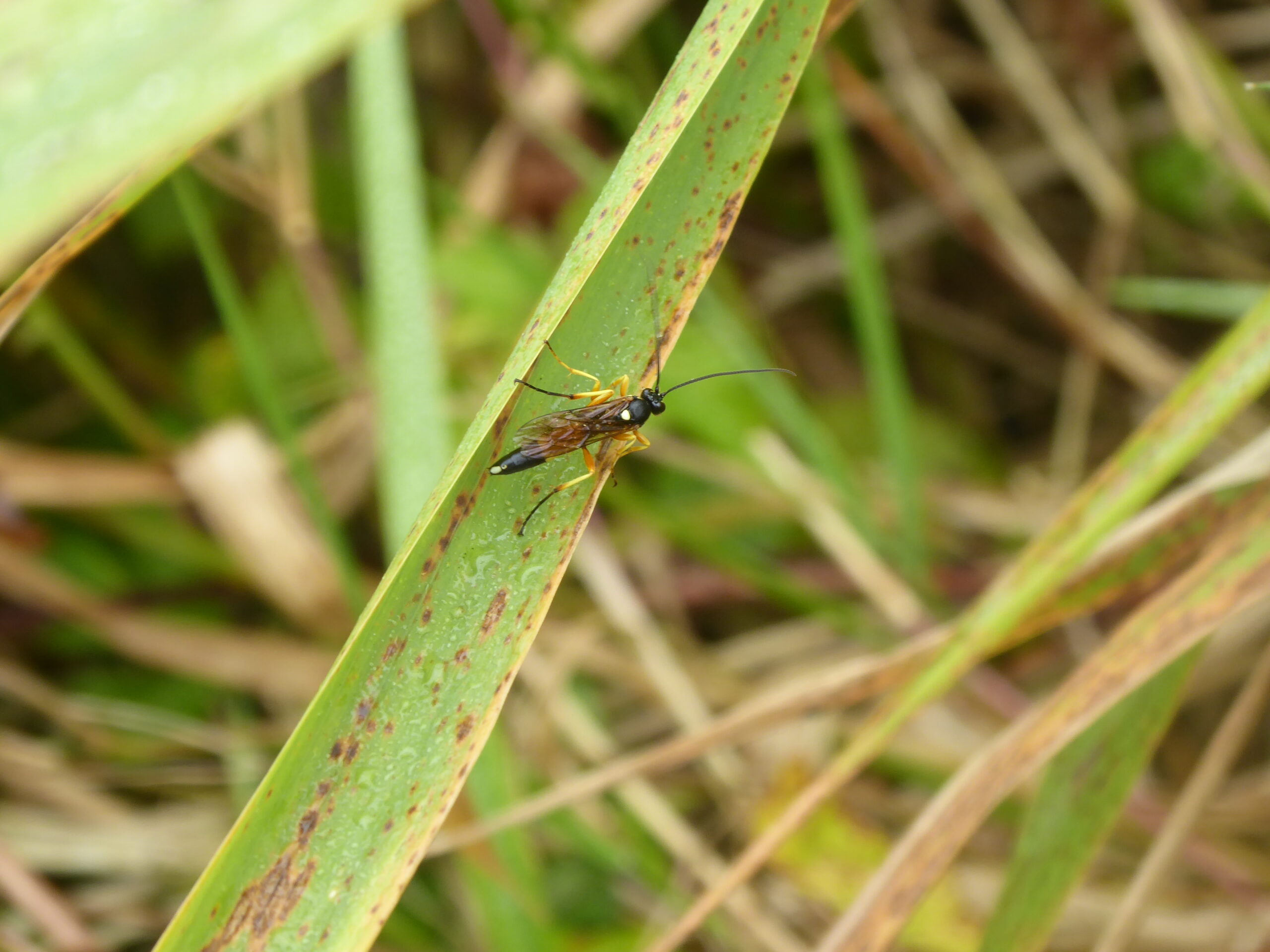
The other day when I was wandering around not expecting to see a lot, I saw two kinds of wasp. The usual wasps were busy at work in the willows, but in the cutting just below the bank (that we call ‘Hard Knott Pass’ after one of the hairier passes in the Lake District), I came across this Ichneumon (pronounced Ick Newman) Wasp.
As usual, there are many sub-species of Ichneumonoids, around 2500 in the UK alone. So, I was lucky to find one that was easily identified. The Diphyus quadripunctorius is black and yellow with distinctive white spots on its back and tail. Its name would suggest four spots and I think two might be under the wings. The females are identified by having orange thighs on their back legs and yellow on their antennae. I think this is a male, as although his back thighs look dark, he definitely has all black antennae.
Ichneumon wasps are solitary and nearly all are parasites. The Diphyus lays its eggs in a host, a moth caterpillar, and then the larvae hatch and eat the host, after which they pupate until they are ready to emerge as an adult. They live on the edges of woodlands and in lush grasslands.
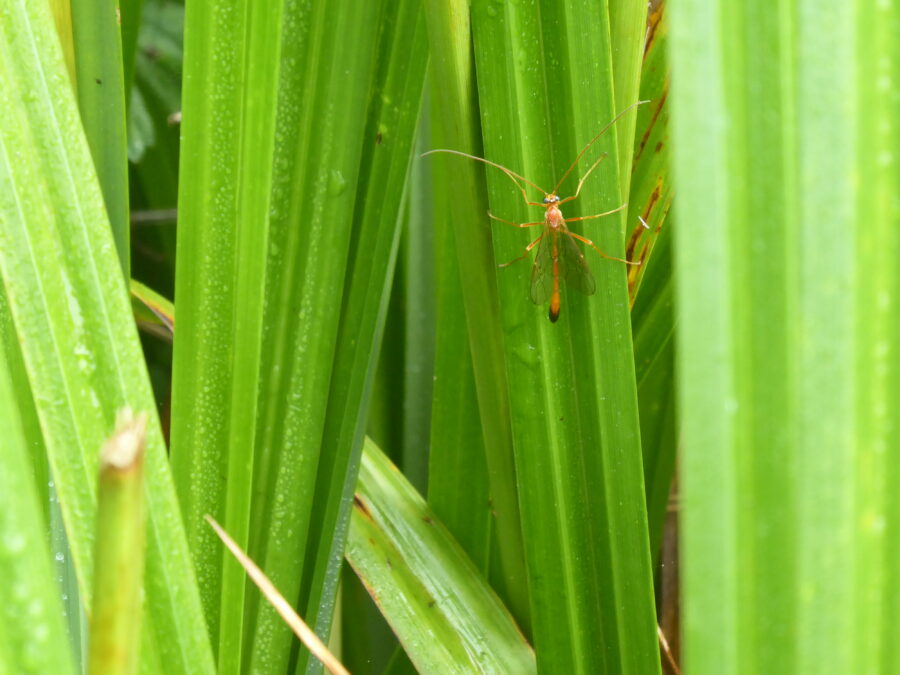
The next wasp I saw in the depths of the grasses was a type of sickle wasp Eniscospilus ramidulus. This, too, is a type of ichneumon wasp. It was easy to identify from its orange body and the black tip on its tail. It also has quite distinctive wings. They have a panel with floating pieces of chitin inside. (You can see triangular shapes if you zoom right in). Chitin is the substance that the shell of an insect is made of. I’m not sure why they have such complicated structures in their wings, but I wonder whether it is to make them reflective (?)
They are supposed to be nocturnal, but the males can be found flying during the day as well, which is just as well really, or I wouldn’t have seen it!
-
Marmalade Hoverfly and Lesser Dung Fly
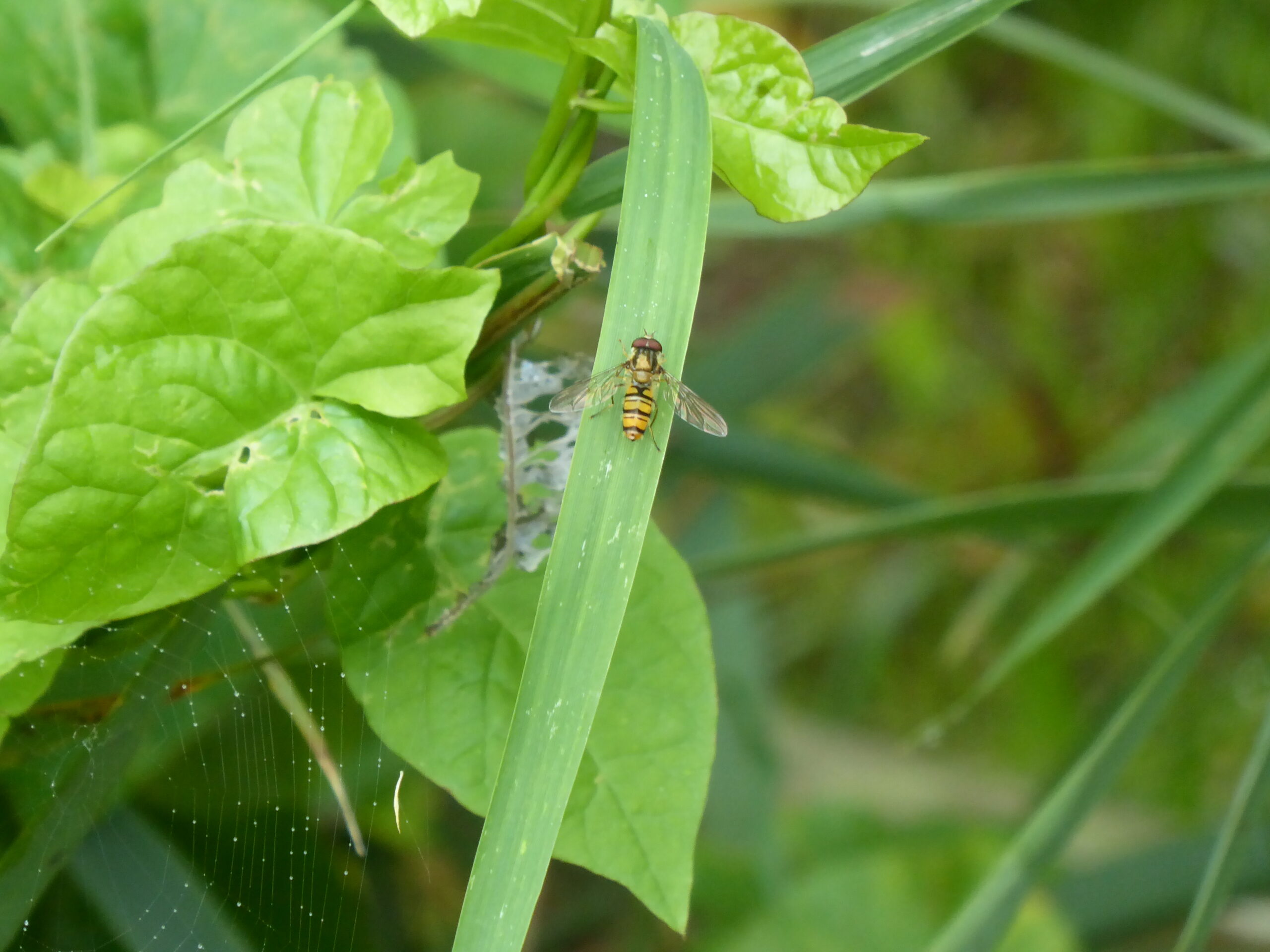
This is a different hoverfly to the long hoverfly and the Melanostoma mellinum. It is a Marmalade Hoverfly because of the two moustache-shaped black bands on its abdomen. Some, but not all, have paler bands like this one, or even white bands. It is possibly the most common hoverfly in Britain. It can be found in gardens, parks and hedgerows and loves a sunny spot.
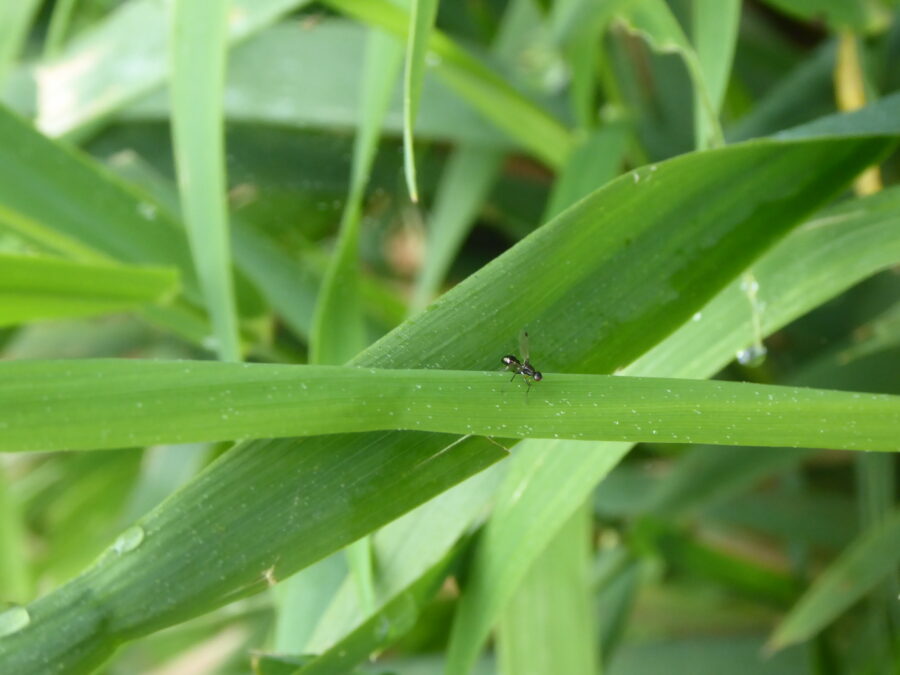
This tiny fly is almost definitely a Lesser Dung Fly, as it has clearly visible dark wing spots, one on each wing. There are many species of dung fly, and it is advisable to identify them with a microscope. However, I didn’t have one handy, so I am relying on the dark wing spots and let’s just say it’s a dung fly that is smaller and less yellow than the Yellow Dung Fly I saw before! They eat what you’d expect a dung fly to eat!
